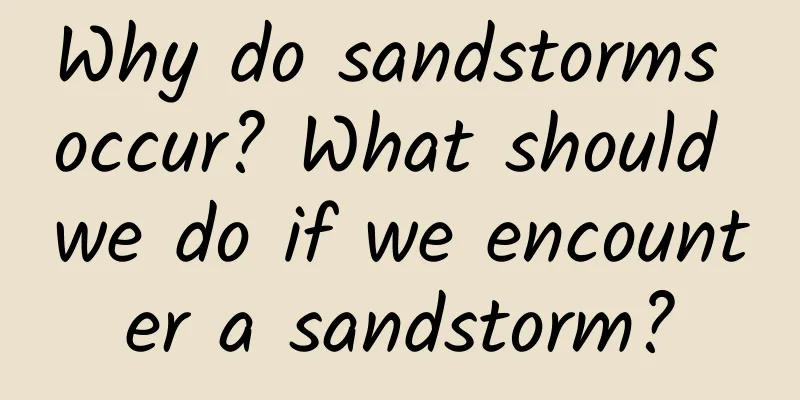Why do sandstorms occur? What should we do if we encounter a sandstorm?

|
Sandstorm is a natural phenomenon with great destructive power. However, due to the development of human life and production activities, the frequency and intensity of sandstorms have increased and strengthened. Blowing sand, as a wind and sand disaster, often occurs in areas with arid climate and sparse vegetation. Next, let's understand what form a sandstorm takes. Contents of this article 1. Why do sandstorms occur? 2. What to do when encountering a sandstorm 3. Is blowing sand a sandstorm? 1Why are there sandstorms?When strong winds come, the dust on the surface is easily blown up and moved, but due to the large size of sand particles, it is not easy to form suspended dust. If the wind lasts for a long time, the suspended dust can be transported to a long distance, and sandstorms will occur in the areas it passes through. Sandstorms have existed since ancient times. They are a natural phenomenon with great destructive power. However, due to the development of human life and production activities, the frequency and intensity of sandstorms have increased and strengthened. The formation of a sandstorm requires four conditions: one is sand and dust on the ground, two is strong winds, three is unstable air conditions, and four is a dry climate environment. The formation of sandstorms is inextricably linked to factors such as the global greenhouse effect, sharp decline in forests, species extinction, the El Niño phenomenon, and vegetation destruction. 2What to do when encountering a sandstormTherefore, in an environment with high concentration of fine suspended particles, you need to pay attention to the following 6 corresponding measures. 1. Avoid going out unless necessary Outdoor activities, camping and other activities that need to be carried out outdoors should be avoided when the suspended particle index is serious. 2. Wear a mask that can block suspended particles when going out South Korea uses "KF80", "KF94" and "KF99" as the density standards for masks. The "80" in "KF80" means that this type of mask can block more than 80% of fine particles, while "KF94" and "KF99" represent that they can block 94% and 99% of fine particles respectively. The Korean government recommends that "KF80" is sufficient to resist harmful substances in the air. Since "KF80" is not enough to block infectious bacteria, if you want to avoid infectious viruses, you should choose masks above "KF94". When purchasing masks, you should choose masks that indicate on the packaging that the particle filtering protection is 80% or above to effectively block suspended particles. 3. When going out, avoid staying in heavily polluted areas and reduce the amount of activity People should avoid staying in places with high concentrations of fine particles, such as roadsides and construction sites, and should also avoid high-intensity activities outdoors to reduce the chance of inhaling fine particles. 4. Wash your hands after going out Since suspended particles easily adhere to exposed clothing, hands, feet, eyes, nose, etc., they should be carefully washed with warm water after returning outdoors to avoid bringing harmful substances back indoors. 5. Drink plenty of water and eat more fruits and vegetables rich in vitamin C Water effectively removes harmful substances from the body, while increasing the water content of the nasal and respiratory mucosa, effectively reducing the chance of suspended particles adhering. Vitamin C has certain anti-inflammatory and anti-oxidation effects. 6. Use public transportation as much as possible Try to avoid using taxis or chartered cars to reduce the number of vehicles on the road, thereby reducing road exhaust emissions. If the destination is close, you can choose to walk or ride a bicycle. 3Is blowing sand a sandstorm?No. Both blowing sand and sandstorms are dust weather, which are caused by a large number of extremely fine dust particles or smoke particles floating in the air, affecting the air and causing the horizontal visibility to be less than 10 kilometers. In terms of intensity, the intensity of sandstorms is stronger than blowing sand. The horizontal visibility of blowing sand is between 1 km and 10 km, while the horizontal visibility of a sandstorm is less than 1 km. Blowing sand, as a wind-blown disaster, often occurs in areas with arid climate and sparse vegetation. |
<<: What is the reason for the baby's snoring? What should I do if the baby snores?
>>: Let’s be healthy and “bullish” in the new year!
Recommend
Health Science: How to deal with diarrhea in summer?
Summer is the peak season for diarrhea. Many peop...
How to prevent stretch marks
Pregnancy is a difficult and noble thing for wome...
Can I eat cucumbers during confinement?
Some dietary taboos during the confinement period...
What is vaginal discharge?
Due to sexual stimulation and mental excitement, ...
What are the healthy ways to lose weight after childbirth?
After giving birth, women cannot choose weight lo...
Low blood pressure during breastfeeding
Basically, most women have more or less low blood...
Is it okay to have black blood clots during menstruation?
We all know that normal menstrual blood is usuall...
What to eat to get the thinnest belly for women
I believe that many people always find that their...
Why do girls have menstruation?
Every adult female will experience vaginal bleedi...
The dangers of extreme anger during menstruation
Some male friends will obviously feel that some w...
How big is the fetus at 15 weeks of pregnancy?
After becoming pregnant, mothers are always looki...
Physical sunscreen that pregnant women can use
Generally, pregnant women need to be very careful...
Who needs cervical cancer screening? Do I need screening after getting the HPV vaccine?
First, let's learn about cervical cancer. In ...
Is it more painful to deliver a second baby by cesarean section than the first?
We all know that childbirth is the most painful o...









